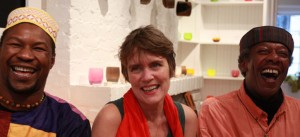Terre Roche, on the “New Busking” in the Music Biz
 I’ve written on this blog about the delightful Friday night singing circle that longtime singer and songwriter Terre Roche leads in NY’s Battery Park most Friday nights in May and June. My wife and son and I went on June 8th and we had a good time, singing along to songs like “The Weight,” “Bird on a Wire,” and “The City of New Orleans,” while getting rained on by a lower Manhattan sun squall and seeing a rainbow.
I’ve written on this blog about the delightful Friday night singing circle that longtime singer and songwriter Terre Roche leads in NY’s Battery Park most Friday nights in May and June. My wife and son and I went on June 8th and we had a good time, singing along to songs like “The Weight,” “Bird on a Wire,” and “The City of New Orleans,” while getting rained on by a lower Manhattan sun squall and seeing a rainbow.
I’ve also read and enjoyed Terre’s sister Suzzy’s current novel, Wayward Saints, so for me the past few months has been a Roches-inflected season, discovering and rediscovering their creativity. They are clearly a very talented family, and don’t just rest on their laurels for things they did back in the day (with third sister Maggie) as The Roches, with great songs like “Hammond Song,” with its theremin-like lead instrument. It’s still a beautiful song, and deserves a fresh listen, if you haven’t heard it recently, or ever.
Today, Terre’s published a self-aware NY Times opinion piece titled The New Busking, a somewhat rueful take on how she’s found that trying to generate support for her current music project, a fusion called Afro-Jersey, through Kickstarter and Indiegogo* has inevitably shifted her focus away from creating and more toward networking. Her column reminds me of similar laments I’ve heard from authors who regret the things they have to do get published, or even to surface amid the bevy of authors and books out there nowadays.
As a longtime bookseller, editor, and publisher–in short, not an artist but a member of the commercial class that promotes creative work and shares it with the public, or declines to do so–I have no easy answer for those authors, or for Terre. This is the pass we have come to in the early 21st century–the new busking, indeed. Still, I did want to make note of Terre’s column and say I recognize the dilemma and the struggle. Somehow, though, I remain hopeful that even while Web platforms such as those she engaged represent a distraction from creative work, they also offer a chance for that work to be heard, seen, and read. Clearly, for better and/or worse, there’s no going back.
